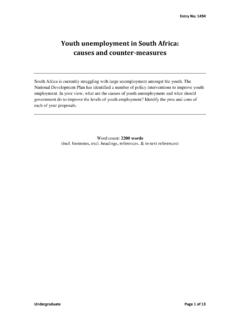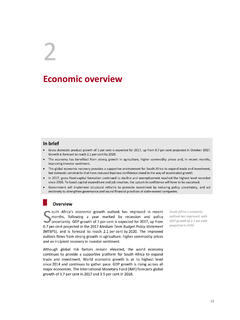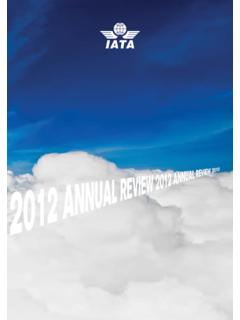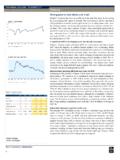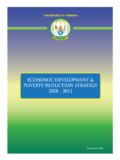Transcription of The New Growth Path: Small Business Sector
1 Entry No: 105. The New Growth Path: Small Business Sector Small Business is praised for its potential to create jobs and grow the economy. Do you believe that overall policy in the form of the newly released New Growth Path and the Industrial Policy Action Plan together with the budget support the development of Small Business in South Africa? Substantiate your answer with references to the relevant documents. Any Growth path must be judged not by the targets for job creation it sets, but by the instruments of macroeconomic management it adopts. (NUMSA, 2011). [ 2198 words]. Undergraduate Page 1 of 11. Entry No: 105. 1. Introduction Implemented late 2010, the New Growth Path (NGP) focuses primarily on employment creation as its pinnacle crux, with the vision of 5 million jobs being created by 2020 (New Growth Path, 2010:8). Analogous to its predecessors (RDP, GEAR and AsgiSA), the NGP. sets out multiple ambitious targets, much to the scepticism of many economic debates.
2 This essay will prove to contend that the NGP and its ancillary initiatives will substantially support the development of Small Business , and consequently aid in economic Growth and job-creation. Firstly, a background of the Small Business Sector will be provided in order to assert the relevance of the Sector as a key driver of the economy. Then an analysis of the micro- and macro-economic policies will be provided, focusing primarily on the effect the policies have on Small Business . International comparisons will also be made, with the case of Brazil, a key BRICS member. Finally, alleged drawbacks of the NGP will be rebutted; some with the aid of the projected rand-dollar exchange rate vis- -vis the minimal effectiveness of the NGP. 2. Background Small Business in South Africa is incorporated in the collective category: Small , Micro and Medium Enterprises (SMME) (Ntsika, 1999:16). The SMME Sector in South Africa comprises a significant contribution to both economic Growth and employment.
3 The Sector currently boasts a 30% contribution to national GDP (Herrington, 2007). It also accounts for 73% GDP in the community, social and personal services category, and a prominent contribution (approximately 60%) to agricultural, trade and construction industries (Herbst, 2001:111). Furthermore, Small Business contributes 61% of total national employment (Herbst, 2001:112).1. Strong evidence certainly suggests of the potential influence that Small Business has on the success of the NGP. To date, it has been argued that Small businesses are not adequately playing their expected role in the economy (Agupusi, 2007). This is due to a number of constraints, viz. policies which do not sufficiently deal with the semi-formal and informal Business sectors, and the restrained capital allocations given by government institutions such as the Khula Fund and the Industrial Development Corporation (IDC) (Agupusi, 2007).
4 With the revision of these drawbacks under the NGP, Small businesses now certainly have an increased potential to be a greater engine for economic Growth and employment creation. 3. NGP Policies: Micro- and Macr0-environment In order to establish the strength of the NGP, it is necessary to study the various micro- and macro-environment policies which form the basis of the policy document. The fundamental policies include (but not limited to): competition, infrastructure, trade, procurement, financing and tax relief. 1. Estimates are subject to variation due to poor SMME data collection prior to year 2000. See Ntsika (1999:61). Undergraduate Page 2 of 11. Entry No: 105. Competition The first identifiable manner in which the NGP proves to favour SMME-generated economic and employment Growth is through its competition policy. In the president's State of the Nation Address (2012), strong attention was directed to policy developments with a high domestic focus.
5 Much to the benefit of SMMEs, the NGP has adopted a more pro-active stance by reiterating the need for a stronger domestic competition policy. The promotion of fair competition, including more stringent laws and financial consequences against anti- competition, is inherent to the success of Small Business (Etro, 2007a). The NGP's adapted2. competition policy signals a greater effort to prevent price fixing, market division and collusive tendering, which often marginalises Small businesses out of markets (Alexander, 2004:136). One can further find indications of the success potential of the policy: Kampel's (2004) 3. recommendations of the dire need to improve on the effectiveness of the prior competition policy, in relation to its time- and cost-constraints as well as its inaccessibility against Small Business , extensively form the basis of the adapted NGP policy. Advocates of competition argue that the adapted policy will remarkably break the barriers-to-entry into markets for SMMEs (Lake 2011:5).
6 SMMEs will further benefit due to an increased economies-of-scale, resulting in more globally competitive SMMEs (NIPF, 2004). Trade Policy SMMEs are further supported to advance the goals of the NGP through the trade policy. The NGPs trade policy is focused on (a) promoting exports, (b) tackling unfair competition against domestic producers, and (c) assisting new activities to achieve competitiveness (New Growth Path, 2010:17). A review of the trade policy by The Task Group of the Policy Board 4. (2011) estimates that SMMEs will contribute over 50% of GDP by the year 2020, indicating a 20% increase in the expected impact SMMEs will have on economic Growth . Local Procurement Under the Preferential Procurement Policy Framework Act (PPPFA), the NGP prescribes local procurement by public entities in an attempt to promote domestic production (New Growth Path, 2010:17). To the benefit of SMMEs, as further stated by Rogerson (2004:25), local procurement will provide trade and employment opportunities for Small Business , and further facilitate social and economic development.
7 The benefits of local procurement include the promotion of heightened domestic competition and innovation (Thai, 2007b), which increases the efficiency of the economy. An increase in efficiency will certainly lead to further economic Growth . In addition, Dodgeson et al. (2005) describes local procurement as a job-driver for Small Business , which can further reduce the distributional inequalities faced by society. Local procurement as a policy instrument will drive Small Business to amplified 2. Adapted from the Competition Amended Act [No. 15 of 2000]. 3. See The Role of South African Competition Law in Supporting SMEs (2004). 4. The Task Group's estimations point to a probable contribution to GDP of more than 50%. See A SUPPLY-SIDE. REGULATORY REVIEW By The Task Group of the Policy Board for Financial Services and Regulation (2008). Undergraduate Page 3 of 11. Entry No: 105. profitability, output and employee Growth , with more than 40% of Small businesses projected to expand (Kruger, 2011).
8 Payment Policy To cure the prolonged cash-flow problems faced by many Small businesses, public entities are now required to provide payment within 30 days to all local suppliers (New Growth Path, 2010:21). Evidently, as argued by Rogerson (2004:26), such a payment policy protects the interests of Small Business and places them at an advantage within the domestic environment, enabling them to contribute significantly to GDP and participate as a key driver of employment. With over of SMMEs in the Free State province alone experiencing cash-flow related failures (FS Provincial Profile, 2005:119), the policy is indeed a step in the right direction. Additionally, name-and-shame consequences increase the level of impact the policy has (pro Small Business ). Name-and-shame strategies have proven to be an effective tool in policy implementation over the past decade (Beck, 2008). Financing Under the auspice of the NGP, the Industrial Development Corporation (IDC) has substantially increased its capacity for lending to local firms and key job drivers over the next five years to over R10 billion (Patel, 2012:2).
9 Reported by Statistics SA (2009), of Small Business owners require start-up capital, with only obtaining loans. The South African Yearbook (2000:256) further cites that between 70% and 80% of SMMEs in South Africa fail, due largely to limited access to finance (see appendix: Figure 2 & Figure 3). Further findings by Sweeny et al. (2006) indicate that 56% of SMME's still require funding three years after start-up (see Figure 1 below). Figure 1: SMME Prolonged Access to Financial Problems Sources: Sweeny, Williams and Anderson, 2006. In the second budget of the EDD, Minister Ebrahim Patel proposed an increased R219, 4. million for Small Business funding, through transfers to Khula and the South African Micro- Finance Apex Fund (SAMAF). The increase in funding opportunities for SMMEs will, as argued by Sweeny et al. (2006), support the Growth of the Sector by incentivising Small Business owners to start and/or expand their Business .
10 Further notable reductions in the failure rate of SMMEs can be anticipated (Rogerson, 2004:56). Ultimately, the increased funding opportunities will encourage unemployed people to move into self-employment (Mangat, 2012), further increasing the number of profitable projects being established. Undergraduate Page 4 of 11. Entry No: 105. Single Funding Agency The NGP assures a single SMME funding agency through the consolidation of Khula, SAMAF and the IDC (New Growth Path, 2010:21). In the 2009 Global Entrepreneurship Monitor Report, Brazil5 was ranked the sixth most entrepreneurial country, compared to South Africa's thirty-fifth ranking. The Trade and Industrial Policy Strategies Report (TIPS, 2008:143) also found that South Africa's array of funding agencies, in comparison to Brazil's single agency, produced a lack of co-ordinated strategies and was confusing for both Business owners and government.
